Why does a gas cylinder become covered with frost: reasons for gas freezing in the cylinder and ways to prevent it
One of the most common problems with gas equipment that runs on mixed propane and butane is the formation of frost on the surface of the gas cylinder. This indicates that the gas inside the metal container is freezing. This problem contributes to the incorrect operation of gas equipment or the complete cessation of gas supply from the cylinder.
So why does a gas cylinder become covered with frost and how can you avoid this problem? This article contains comprehensive information about the causes of frost formation and ways to prevent it, on the basis of which you can ensure the proper operation of your equipment.
The content of the article:
Reasons for the formation of frost on the cylinder
Let's try to figure out why it happens that the gas in a cylinder located outside freezes when the air temperature drops.
So, first you need to understand that cooling of particles occurs with intensive release of gas from the cylinder. Since the gas inside the container is pumped under pressure, it is concentrated in a liquid state. As a result, partial freezing of the liquid gas occurs during its release.
As is known, gas cylinders are refilled approximately 80%. This is done for reasons of safe operation of gas equipment. Since gas tends to expand, this can lead to the balloon bursting due to excess pressure.The expansion of the gas inside the cylinder occurs due to its heating, regardless of the heat source. The expansion process begins even when exposed to direct sunlight or another heating element.
Reason #1 - low air temperature
Based on the practice of using cylinders, the optimal temperature at which the equipment will operate normally is approximately 10 degrees, and when this mark decreases, problems begin with the supply of gas to the system.
If your equipment is located in a heated room, then you should not pay attention to these indicators. You also don’t have to worry about your gas cylinder freezing and breaking down if you leave it in a room without heating in the winter. Winter temperatures are too low to completely freeze fuel.
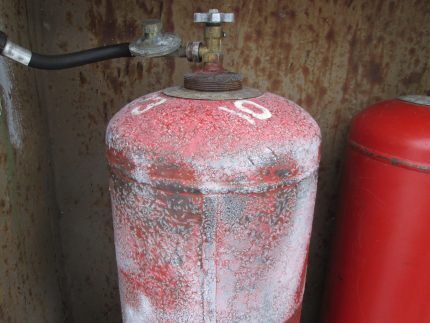
Reason #2 - high butane content
Now let’s figure out whether the gas inside the cylinder can freeze and how to prevent it. So, to ensure proper operation of gas appliances, it is necessary to maintain the correct ratio of propane and butane. The correct proportions will help achieve maximum fuel consumption and correct operation of devices at negative ambient temperatures.
Fuel proportions in summer
As mentioned earlier, the freezing point of butane differs from the freezing point of propane. Through practical research, optimal proportions for equipment operation in winter and summer were determined.
For the warm season, fuel is mixed in the following proportions:
- Propane – 40%;
- Butane 60%.
This ratio is considered the most effective for consumption. It is worth noting that this option has a lower cost than fuel with a “winter” proportion.
Winter fuel proportions
To use gas cylinders in winter, the proportions will be different, namely:
- Propane – 60%;
- Butane – 40%.
In some cases, the amount of propane can be as high as 80 percent. But, given that propane costs more than butane, the final fuel price will also be higher.
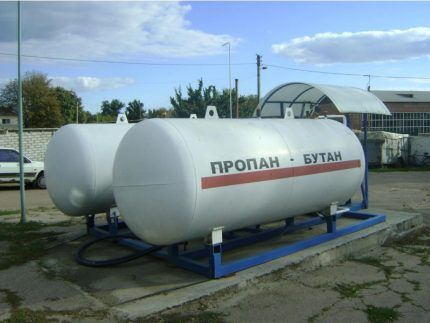
We talked in more detail about the types of gas mixtures in cylinders in this material.
Gas freezing point
Now let's talk about the temperature at which the gas in the cylinder usually freezes.
And the temperature of complete freezing of these components is different:
- Propane freezes at -188 degrees;
- Butane freezes at a temperature of -138 degrees.
Therefore, in the summer, propane is filled into a cylinder in smaller quantities than butane. Very often, unscrupulous companies fill containers with the “summer” concentration option, since the price of propane is cheaper than the cost of butane.

As a result, the gas container quickly freezes if the equipment is installed in an unheated room and the gas supply is stopped.
Reason #3 - increased gas consumption
But still, why does the container become covered with frost only in the place where the gas is in a liquid state? Low ambient temperature is not the only cause of freezing. As you know, a gas stove, fireplace or other equipment that runs from a gas cylinder functions by converting gas from a liquid state to a vapor form.
There are two options for gas conversion, namely:
- fuel heating;
- natural evaporation.
In this case, all particles with powerful kinetic energy are rapidly directed to the upper part of the container and are separated from particles in a liquid state with a lower kinetic potential.
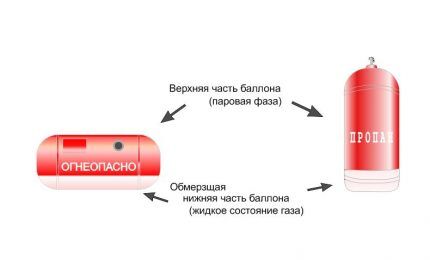
Due to such conditions, liquid fuel begins to lose temperature. It follows from this that as gas consumption increases, the temperature of its liquid state decreases. Simply put, the more fuel the equipment consumes, the faster the gas cylinder will freeze.
As the particles cool, the ability to independently evaporate the liquefied gas decreases. It follows that the colder the particles are, the slower the gas will evaporate. In this case, the equipment begins to work intermittently or stops functioning altogether.
Actions to take when a container freezes
If you notice that your equipment has begun to work intermittently, then you should pay attention to the surface of the gas cylinder. Most likely it was covered with frost.To resume the correct functioning of the equipment, it is necessary to create optimal conditions for this. If this is not done in time, then the gas appliance may completely stop working.
The first step is to determine why freezing occurs. If this is due to weather conditions, then you need to create an optimal temperature regime for the container; how to do this will be written below.
If cooling occurs due to intensive gas consumption, then it is necessary to reduce consumption. This can be done by installing an additional cylinder, or several. Depending on the amount of fuel consumption. Connection of several cylinders is carried out using a special connecting ramps.
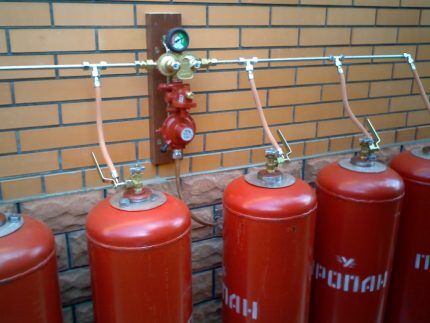
A pressure compensation valve and a pressure gauge must be installed in the rail to monitor the fuel level in the combined system.
How to properly heat a gas cylinder?
Now let’s look at how to ensure proper operation of gas equipment at low air temperatures, and what can be done to prevent gas from freezing. To resolve this issue, there are several options.
First of all, try to move the gas cylinder to a warm room; after some time, the frost from the surface will gradually evaporate, and inside the cylinder the conditions necessary for converting the liquefied gas into a vapor state will form. After this, the gas supply will be restored and the gas appliance can be used for its intended purpose.
But, if it is not possible to move the equipment, then it is necessary to heat the container on site so that the gas inside does not cool. Very often, owners of gas appliances resort to heating the cylinder by direct exposure to fire. It is strictly forbidden to carry out such actions, since this contributes to the rapid conversion of gas into a vapor state; accordingly, the pressure in the container rapidly increases and can cause an explosion.
To reduce the likelihood of fuel cooling, you can insulate the cylinder with special materials that prevent the penetration of cold. But this method is suitable for small temperature changes in the environment.
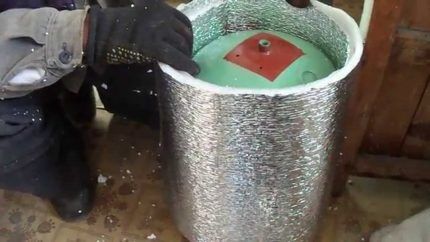
If the temperature outside is colder, then you can use special heating equipment. An electric heater can not only warm up a gas cylinder, but also provide a constant temperature at which the device will perform its functions with the greatest efficiency.
Thus, fuel consumption is reduced by up to 30 percent.
Compliance with safety regulations
It is very important to follow the basic safety regulationsto prevent tragic consequences. Working with gas equipment is extremely dangerous, so it is not recommended to connect or change the structural elements of the equipment yourself.

Before connect the cylinder to the stove or take some action to repair it, it is best to contact gas equipment specialists. If gas installations are handled incorrectly, or operating conditions are violated, the gas cylinder may explode and lead to a fire.
To date, many tragic cases have been recorded, including deaths. Therefore, we strongly recommend that you carry out work related to gas responsibly, as well as when using the equipment.
Conclusions and useful video on the topic
Watch the video to clearly see why a gas appliance freezes. Here you will also see which heater to use to maintain the optimal temperature of the gas inside the cylinder.
Now we know the main reasons why a gas cylinder can freeze. If you notice that your gas cylinder is covered with frost, then you need to take measures to eliminate this problem. Otherwise, the equipment will not be able to function properly, or will stop working altogether, as the cooled gas stops evaporating.
To ensure normal operation of the release of gas molecules, it is necessary to create normal operating conditions (increase the air temperature). If this is not possible, then you can use a special insulation for the cylinder, or install a heating device.
Do you use bottled gas at home? Tell us how you deal with the problem of its freezing, add useful recommendations on methods of insulating the cylinder, take part in the discussion - the comment form is located below.



